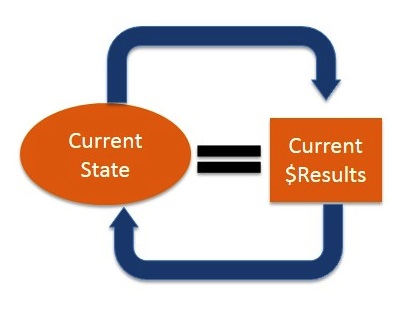What metrics do you use to manage your business? It’s a common question and for many business leaders, generates common answers. Revenue, Unit Costs, Overhead, Operating Profit, Customer Complaints, On-Time Delivery, etc… But when asked, “Are those metrics helping you to grow your business?” the answer is often “No”. That’s because most leadership dashboards focus on lagging indicators instead of those that lead the business to a future state.
Lagging indicators present the success or failure of past business results. Sure it’s important to benchmark progress, but if that’s all you are using to manage your business, you may be hurting your business’s future. Why? Because you spend too much time focusing on money. Yes I said it…a business leader should not be focused on money.
This may seem like a crazy statement, but I assure you, I have not lost my mind. Actually I’d argue that those who focus their time on money are the ones with issues.
Issues like…
-
Low employee morale
-
High turnover rate
-
Lack of innovative ideas
-
Stagnant growth
-
Declining profitability
…to name a few
Let’s apply some perspective to the notion that “it’s not about money”.
It comes down to this…money, whether you have a lot or little of it, is the result of everything else you do. Focusing on the result, takes the focus away from doing the things that make your business grow profitably.
When you manage results, you manage the past. In fact, leaders that focus on money are more likely to make decisions that damage their business rather than grow it.
Here are some common mistakes leaders make:
-
Cost cutting for short-term gain, without assessing the long-term implications to the business.
-
Cost avoidance, not investing in productivity or opportunities that will pay back in business growth.
-
Hiring or firing talent based on cost, rather than the value an individual brings to the organization.
And do you want to know the legacy those “money focused” leaders leave? Beyond stagnant to poor results, they leave a reputation of being micromanagers, not leaders.
Here’s what the “Focus On Money” cycle looks like:

The current state of your business “is what it is”, however, the problem many leaders face is that they are not aware of what goes on, what’s working, what’s not working. They focus on the money and make random changes to the current state hoping it will impact results. Ultimately what happens is the destruction of the current state, making it more and more difficult to grow.
This cycle can destroy your business, but don’t worry…there is a solution. Shift your focus to the initiatives necessary to impact your future results in a sustainable way. Although logical, for many business leaders this shift is not easy to do because they are caught in the day-to-day struggles of the current state without the tools or time to get out of it.
I rarely meet leaders that say they like being there. Most business owners want to lead, they want to be strategic…they are just unsure of how to let go and where to focus.
There are three areas leaders should be focusing their time on:
-
Acknowledging the Current State of The Business: People, processes, products, customers & competitors – how does it flow, what works, what doesn’t and what can be improved upon?
-
Envisioning the future state of the business: People, processes, products, customers & competitors – what do you want it to look like, how should it work? What end result ($ or other metrics) do you want it to achieve?
-
Focusing on Initiatives: What game changing activities must take place to transition the business to the future state? Who can you hold accountable to lead each one and what is the timeframe for completion?
Here’s what the “Leadership” cycle looks like:

In this cycle you are not destroying your current state, but creating your future, leading positive change and making a direct impact on your results…yes money, profits and most importantly…sustainable growth.
Leadership drives the business cycle. By defining and acknowledging the current state of the business, envisioning the future state and leading that transition through strategic initiatives that you hold your team accountable to…you are not only shifting your view, but the view of your team…away from money, and on the things that make money. That’s where you want to be.
Your Dashboard Challenge:
1) Take your current leadership dashboard and separate your indicators into two columns.
-
On the left show all of your lagging results (everything representing how your business did last month, last qtr., etc.).
-
On the right side show all of your leading indicators (everything representing how well your future state initiatives are moving forward: on-time project status, new customer bids, new vendor qualifications, etc.)
2) Focus on building the right side of your dashboard.
-
Acknowledge the current state of your business. If you don’t have the time or skill set to evaluate the current state of your business, consider hiring an outside consultant to conduct the research for you.
-
Envision the future state of your business. Compare where you are with where you want to be.
-
Define and assign your Key Initiatives that move your business forward from its current to future state.
-
List status updates for those key initiatives on the right side of your leadership dashboard.
You can’t get to where you want to go if you don’t know where you’re starting from. This is one common reason why leaders fail; the other is the inability to focus people on the things necessary to get there. The more educated the leader, the better he or she can communicate their vision and the more likely their employees will buy in and enthusiastically work to make that vision real.

Written by Lisa Woods, President ManagingAmericans.com Lisa is a dynamic business leader & author with more than 20 years experience leading, managing and driving growth in the corporate world. Today she partners with business leaders to understand their vision, identify internal and external roadblocks, define a practical strategic path forward and guide a successful transformation. This work includes strategy definition & goal setting, organizational design, facilitating team buy-in, establishing visual metrics, internal and external research studies, business feasibility assessments, and investor insight into organizational strength, weakness & strategic opportunity. She helps business leaders drive growth & increase profits.
Did you find this article informative? Let us keep you up-to-date on all of our training articles. Please sign up for our newsletter today!
Here are some additional training articles you may be interested in:
Emotional Intelligence in the Workplace: How to Develop Yourself & Your Team
Lessons Learned Templates & Guide: A Managers Toolkit for Continuous Improvement
Work Efficiency Equation For Managers And High Performers
Overcoming Disconnect Between Middle & Upper Management
Strategic Leadership-How Strategic Are You?
About ManagingAmericans.com
We are America’s Management & Leadership Center for Professional Development. Our well-rounded business content is designed for Leaders & Managers to implement change with ease & improve accountability amongst their teams. Here you’ll find Articles from 30+ Expert Consultants, Coaches & Thought Leaders, access practical Business Templates, learn new skills & connect to our Expert Panel to answer your organizational challenges.